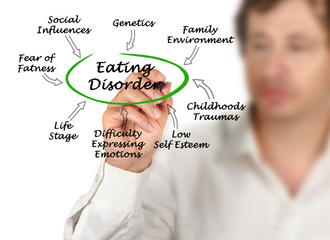Written by: Rebecca Berman, LCSW-C, CEDS-S, MLSP
Clinical Training Specialist, The Renfrew Center

Prior to the DSM-5 (Diagnostic and Statistical Manual) coming out in 2013, ARFID, or Avoidant Restrictive Food Intake Disorder, was referred to as Selective Eating Disorder and is colloquially known as “picky eating”.
But ARFID is so much more than that.
The symptoms of ARFID often interfere with everyday life, and can cause severe medical, emotional and social challenges. Here is what you need to know about it.
ARFID Symptoms & Warning Signs
The first signs of ARFID usually appear in infancy and early childhood and can potentially continue through adulthood. Someone with ARFID may struggle with one or more of the following:
- Sensory Sensitivity: Individuals report extreme sensitivity to certain textures, tastes, smells, and/or appearances of food and often have a limited rotation of safe foods that they’re willing to eat.
- Fear of Aversive Consequences: Individuals experience an intense fear of choking, vomiting, or having an allergic reaction to, etc. certain foods, and will restrict those foods or completely avoid them.
- Lack of Interest: Individuals have no desire to eat and may reach fullness quickly.
How ARFID is Diagnosed
An ARFID diagnosis also requires at least one of the following to be present:
- Significant weight loss and/or failure to meet milestones on a growth chart
- A nutritional deficiency (or related physical issue)
- Dependence on artificial nutrition through a feeding tube (e.g., nasogastric or gastrostomy tube feeding) or oral supplements
- Impairments in psychosocial functioning
Causes & Risk Factors of ARFID
The exact cause of ARFID, or any other eating disorder, is not fully known. However, there seem to be environmental, genetic, temperamental, and biological factors that may contribute to the development and the maintenance of ARFID.
There are certain issues that seem to frequently co-exist with ARFID, including anxiety disorders, autism spectrum disorders (ASD), ADHD, and OCD.
ARFID also seems to occur equally across genders. However, those assigned male at birth seem to be at higher risk for experiencing ARFID and ASD together. Those with congenital and/or neurological conditions might also have problems eating due to issues with the mouth, esophagus, or tongue; ARFID should only be diagnosed when the individual clearly meets criteria for both issues.
ARFID is most often seen in infancy and early childhood, however in some cases, ARFID can develop later in life as a fear-based response to a traumatic experience (e.g., a memory of choking on food or a distressing medical procedure).
Complications of Living With ARFID
ARFID can have a negative impact on physical health due to malnourishment, while also damaging the individual’s relationships with family and friends.
Imagine, for example, that someone was only comfortable eating lumpy foods so they would eat mostly mashed potatoes, oatmeal and yogurt. Not only are there many nutrients not being met through those foods, but it makes the ability to be social very difficult. If this individual is invited on a dinner date, or to a neighbor’s BBQ, or a family celebration, they would have very limited options; go and don’t eat, go and bring their own food or don’t go at all.
In all three situations, food is interfering with the ability to be social and have relationships.
ARFID can also be associated with significant stress within a family system. Caretakers may experience intense anxiety and fear associated with their child’s health and wellbeing, resulting in emotionally driven conflict during mealtimes and/or disagreements between partners about how to help the child.
Additionally, there are intense, anticipatory emotions that make it difficult for those with ARFID to approach feared foods. We all have the tendency to get stuck in avoidance patterns and these can be very difficult to break without professional support.
Treating ARFID
Nutritional deficiencies, low weight and malnourishment are often a result of the restriction or avoidance of food. And the medical complications can be nearly identical to what is typically seen in those with Anorexia Nervosa or other restrictive eating disorders.
A thorough medical assessment is needed to identify and treat any acute medical issues and ongoing monitoring may be recommended. A dietitian with eating disorder experience can help create and oversee a structured, do-able meal plan that meets the individual’s metabolic needs and supports weight restoration, if necessary.
At Renfrew’s residential programs, occupational therapists design and implement gradual exposures to help the individual increase tolerance to a wider variety of food, while a primary therapist addresses any underlying emotional and relational issues.
Eating disorders are typically fueled by the desire to avoid emotions—we have found that is no different for those with ARFID. Therefore, individual, family therapy, group therapy, and/or psychotropic medications can be helpful components in the treatment process.
There has been a lot of discussion surrounding ARFID and body image. ARFID has been known as the eating disorder that doesn’t have a body image component and in fact one cannot technically be diagnosed with ARFID according to the DSM-5 if their restricting is a direct attempt to change body size, weight, or shape. However, we cannot isolate disorders from our culture.
Conclusion
We live in a culture that is overrun by weight stigma, fat phobia and diet culture. To expect that someone isn’t going to be impacted by that seems unlikely.
When assessing for ARFID, we must consider the possibility that someone may have a diagnosis such as anorexia, bulimia, OSFED, or binge eating disorder, and still have ARFID tendencies including sensory sensitivity, fear of aversive consequences and/or lack of interest in eating.
ARFID cannot be diagnosed if the restriction or avoidance of food is better explained by another eating disorder.
Recovery from ARFID is possible. The goals of the treatment remain the same, focusing on medical stabilization, nutritional rehabilitation, impacts of experiential avoidance, and emotional awareness. Multi-disciplinary treatment teams should consider the possibility of ARFID tendencies when conceptualizing and treating individuals with eating disorders.


